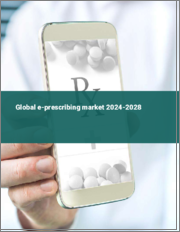
|
시장보고서
상품코드
1630684
전자 처방전 시장 규모, 점유율, 성장 분석 : 제품 유형별, 전달 모드별, 최종사용자별, 사용 방법별, 물질별, 전문 분야별, 지역별 - 산업 예측(2025-2032년)E-Prescription Market Size, Share, Growth Analysis, By Product Type (Solutions, Services), By Delivery Mode (Web-based, Cloud-based), By End-User, By Usage Methods, By Substances, By Specialties, By Region - Industry Forecast 2025-2032 |
||||||
세계의 전자 처방전 시장 규모는 2023년에 36억 6,000만 달러로 평가되며, 2024년 46억 4,000만 달러에서 2032년에는 310억 1,000만 달러로 성장하며, 예측 기간(2025-2032년)의 CAGR은 26.8%로 성장할 전망입니다.
처방 오류는 의료 현장에서 보고되는 약물 관련 사고의 72% 이상을 차지하며, 전 세계 의료진에게 심각한 우려를 불러일으키고 있습니다. 이러한 실수가 사망 사고로 이어지는 경우는 드물지만, 환자에게 심각한 건강상의 위험을 초래하고 의료 전문가에 대한 법적 조치로 이어지는 경우가 많습니다. 이 문제를 해결하기 위해 전자처방전(e-prescribing)이 효과적인 해결책으로 떠오르고 있습니다. 이 기술을 통해 의료진은 처방전을 전자적으로 약국에 보낼 수 있으며, 약물 상호작용을 최소화하고 실수를 줄여 환자의 안전을 강화할 수 있습니다. 또한 e-prescribing은 기존 방식에 비해 비용 효율적이고 효율적인 대안을 제공하여 처방 프로세스를 간소화합니다. 다양한 의료 시설에서 전자처방전 시스템을 도입할 것으로 예상되는 것은 의료의 질을 향상시키는 데 있으며, 이 기술에 대한 수요가 증가하고 있음을 보여줍니다.
목차
서론
- 조사의 목적
- 조사 범위
- 정의
조사 방법
- 정보 조달
- 2차 데이터와 1차 데이터 방법
- 시장 규모 예측
- 시장의 전제조건과 제한
개요
- 세계 시장 전망
- 공급과 수요의 동향 분석
- 부문별 기회 분석
시장 역학과 전망
- 시장 개요
- 시장 규모
- 시장 역학
- 촉진요인과 기회
- 억제요인과 과제
- Porter의 산업 분석
주요 시장 인사이트
- 주요 성공 요인
- 경쟁의 정도
- 주요 투자 기회
- 시장 에코시스템
- 시장의 매력 지수(2024년)
- PESTEL 분석
- 거시경제 지표
- 밸류체인 분석
- 가격 분석
- 사례 연구
- 기술의 진보
- 규제 상황
- 스타트업 분석
- 특허 분석
전자 처방전 시장 규모 : 제품 유형별
- 시장 개요
- 솔루션
- 통합 솔루션
- 스탠드얼론 솔루션
- 서비스
- 실장 서비스
- 지원 및 정비 서비스
- 트레이닝 및 교육 서비스
전자 처방전 시장 규모 : 전달 모드별
- 시장 개요
- 웹 기반
- 클라우드 기반
- 온프레미스
전자 처방전 시장 규모 : 최종사용자별
- 시장 개요
- 병원
- 클리닉
- 약국
- 외래 수술 센터
- 기타
전자 처방전 시장 규모 : 사용 방법별
- 시장 개요
- 핸드헬드
- 컴퓨터 기반 디바이스
전자 처방전 시장 규모 : 물질별
- 시장 개요
- 규제 물질
- 규제 대상외 물질
전자 처방전 시장 규모 : 전문 분야별
- 시장 개요
- 종양학
- 스포츠 의학
- 신경학
- 심장병학
- 기타
전자 처방전 시장 규모
- 북미
- 미국
- 캐나다
- 유럽
- 독일
- 스페인
- 프랑스
- 영국
- 이탈리아
- 기타 유럽 지역
- 아시아태평양
- 중국
- 인도
- 일본
- 한국
- 기타 아시아태평양
- 라틴아메리카
- 브라질
- 기타 라틴아메리카 지역
- 중동 및 아프리카
- GCC 국가
- 남아프리카공화국
- 기타 중동 및 아프리카
경쟁 정보
- 상위 5사의 비교
- 주요 기업의 시장 포지셔닝(2024년)
- 주요 시장 기업이 채택한 전략
- 시장의 최근 동향
- 기업의 시장 점유율 분석(2024년)
- 주요 기업의 기업 개요
- 회사 개요
- 제품 포트폴리오 분석
- 부문별 점유율 분석
- 매출의 전년대비 비교(2022-2024)
주요 기업 개요
- CVS Health Corporation(United States)
- Giant Eagle Inc.(United States)
- Lloyds Pharmacy Limited(United Kingdom)
- Rowland Pharmacy(United Kingdom)
- The Kroger Co.(United States)
- Walmart Inc.(United States)
- Cerner Corporation(United States)
- Allscripts Healthcare Solutions, Inc.(United States)
- McKesson Corporation(United States)
- Athenahealth, Inc.(United States)
- Medtronic plc(Ireland)
- Siemens Healthineers AG(Germany)
- GE Healthcare(United States)
- Philips Healthcare(Netherlands)
- IBM Watson Health(United States)
- Oracle Corporation(United States)
결론과 권장사항
KSA 25.02.24Global E-Prescription Market size was valued at USD 3.66 billion in 2023 and is poised to grow from USD 4.64 billion in 2024 to USD 31.01 billion by 2032, growing at a CAGR of 26.8% during the forecast period (2025-2032).
Prescription errors represent over 72% of drug-related incidents reported in healthcare settings, raising significant concerns for medical practitioners globally. While these mistakes rarely lead to fatalities, they pose serious health risks for patients and often result in legal actions against healthcare professionals. To combat this issue, electronic prescribing (e-prescribing) has emerged as an effective solution. This technology allows medical providers to electronically send prescriptions to pharmacies, enhancing patient safety by minimizing drug interactions and reducing errors. Additionally, e-prescribing offers a more cost-effective and efficient alternative to traditional methods, streamlining the prescription process. The anticipated growth in the adoption of e-prescribing systems across various medical facilities indicates a rising demand for this technology in enhancing the quality of care.
Top-down and bottom-up approaches were used to estimate and validate the size of the Global E-Prescription market and to estimate the size of various other dependent submarkets. The research methodology used to estimate the market size includes the following details: The key players in the market were identified through secondary research, and their market shares in the respective regions were determined through primary and secondary research. This entire procedure includes the study of the annual and financial reports of the top market players and extensive interviews for key insights from industry leaders such as CEOs, VPs, directors, and marketing executives. All percentage shares split, and breakdowns were determined using secondary sources and verified through Primary sources. All possible parameters that affect the markets covered in this research study have been accounted for, viewed in extensive detail, verified through primary research, and analyzed to get the final quantitative and qualitative data.
Global E-Prescription Market Segmental Analysis
Global E-Prescription Market is segmented by Product Type, Delivery Mode, End-User, Usage Methods, Substances, Specialties and region. Based on Product Type, the market is segmented into Solutions and Services. Based on Delivery Mode, the market is segmented into Web-based, Cloud-based and On-premise. Based on End-User, the market is segmented into Hospitals, Clinics, Pharmacies, Ambulatory Surgical Centers and Others. Based on Usage Methods, the market is segmented into Handheld and Computer Based Devices. Based on Substances, the market is segmented into Controlled Substances and Non-controlled Substances. Based on Specialties, the market is segmented into Oncology, Sports Medicine, Neurology, Cardiology and Others. Based on region, the market is segmented into North America, Europe, Asia Pacific, Latin America and Middle East & Africa.
Driver of the Global E-Prescription Market
One of the key drivers of the global e-prescription market is the growing emphasis on eliminating adverse drug events (ADEs) and reducing medical errors in healthcare. Medication mistakes can significantly compromise patient health, making it essential for healthcare providers to utilize robust e-prescribing systems. These systems enable clinicians to access comprehensive patient records, including medical histories, current medications, and diagnoses, thereby enhancing patient safety and minimizing the likelihood of errors. As the incidence of medication errors and drug-related side effects continues to escalate worldwide, the demand for e-prescribing solutions is expected to surge, further propelling market growth.
Restraints in the Global E-Prescription Market
The global e-prescription market faces significant restraints, primarily due to the high expenses associated with the implementation and maintenance of integrated e-prescribing systems. Even though these systems are gaining traction in various clinical environments, their steep costs deter broader acceptance, particularly in developing regions where financial resources are limited. Moreover, the absence of adequate healthcare IT infrastructure in many emerging economies further hinders the growth of this market. As a result, the combination of high investment requirements and insufficient support systems poses a considerable challenge to the widespread adoption of e-prescribing solutions across the globe.
Market Trends of the Global E-Prescription Market
The global e-prescription market is poised for significant growth, driven by the integration of e-prescribing software with Electronic Health Record (EHR) systems. This integration provides numerous advantages, including access to clinical notes, laboratory data, and clinical decision support tools, which standalone systems lack. By enhancing patient medication histories and pharmacy benefits information, EHR-connected e-prescriptions make critical drug data readily available, thereby reducing prescription errors in community healthcare settings. Additionally, increasing government initiatives to implement integrated EHR systems in hospitals further propel market expansion, highlighting the crucial role of technology in improving patient safety and healthcare efficiency.
Table of Contents
Introduction
- Objectives of the Study
- Scope of the Report
- Definitions
Research Methodology
- Information Procurement
- Secondary & Primary Data Methods
- Market Size Estimation
- Market Assumptions & Limitations
Executive Summary
- Global Market Outlook
- Supply & Demand Trend Analysis
- Segmental Opportunity Analysis
Market Dynamics & Outlook
- Market Overview
- Market Size
- Market Dynamics
- Drivers & Opportunities
- Restraints & Challenges
- Porters Analysis
- Competitive rivalry
- Threat of substitute
- Bargaining power of buyers
- Threat of new entrants
- Bargaining power of suppliers
Key Market Insights
- Key Success Factors
- Degree of Competition
- Top Investment Pockets
- Market Ecosystem
- Market Attractiveness Index, 2024
- PESTEL Analysis
- Macro-Economic Indicators
- Value Chain Analysis
- Pricing Analysis
- Case Studies
- Technology Advancement
- Regulatory Landscape
- Startup Analysis
- Patent Analysis
Global E-Prescription Market Size by Product Type & CAGR (2025-2032)
- Market Overview
- Solutions
- Integrated Solutions
- Standalone Solutions
- Services
- Implementation Services
- Support & Maintenance Services
- Training & Education Services
Global E-Prescription Market Size by Delivery Mode & CAGR (2025-2032)
- Market Overview
- Web-based
- Cloud-based
- On-premise
Global E-Prescription Market Size by End-User & CAGR (2025-2032)
- Market Overview
- Hospitals
- Clinics
- Pharmacies
- Ambulatory Surgical Centers
- Others
Global E-Prescription Market Size by Usage Methods & CAGR (2025-2032)
- Market Overview
- Handheld
- Computer Based Devices
Global E-Prescription Market Size by Substances & CAGR (2025-2032)
- Market Overview
- Controlled Substances
- Non-controlled Substances
Global E-Prescription Market Size by Specialties & CAGR (2025-2032)
- Market Overview
- Oncology
- Sports Medicine
- Neurology
- Cardiology
- Others
Global E-Prescription Market Size & CAGR (2025-2032)
- North America (Product Type, Delivery Mode, End-User, Usage Methods, Substances, Specialties)
- US
- Canada
- Europe (Product Type, Delivery Mode, End-User, Usage Methods, Substances, Specialties)
- Germany
- Spain
- France
- UK
- Italy
- Rest of Europe
- Asia Pacific (Product Type, Delivery Mode, End-User, Usage Methods, Substances, Specialties)
- China
- India
- Japan
- South Korea
- Rest of Asia-Pacific
- Latin America (Product Type, Delivery Mode, End-User, Usage Methods, Substances, Specialties)
- Brazil
- Rest of Latin America
- Middle East & Africa (Product Type, Delivery Mode, End-User, Usage Methods, Substances, Specialties)
- GCC Countries
- South Africa
- Rest of Middle East & Africa
Competitive Intelligence
- Top 5 Player Comparison
- Market Positioning of Key Players, 2024
- Strategies Adopted by Key Market Players
- Recent Developments in the Market
- Company Market Share Analysis, 2024
- Company Profiles of All Key Players
- Company Details
- Product Portfolio Analysis
- Company's Segmental Share Analysis
- Revenue Y-O-Y Comparison (2022-2024)
Key Company Profiles
- CVS Health Corporation (United States)
- Company Overview
- Business Segment Overview
- Financial Updates
- Key Developments
- Giant Eagle Inc. (United States)
- Company Overview
- Business Segment Overview
- Financial Updates
- Key Developments
- Lloyds Pharmacy Limited (United Kingdom)
- Company Overview
- Business Segment Overview
- Financial Updates
- Key Developments
- Rowland Pharmacy (United Kingdom)
- Company Overview
- Business Segment Overview
- Financial Updates
- Key Developments
- The Kroger Co. (United States)
- Company Overview
- Business Segment Overview
- Financial Updates
- Key Developments
- Walmart Inc. (United States)
- Company Overview
- Business Segment Overview
- Financial Updates
- Key Developments
- Cerner Corporation (United States)
- Company Overview
- Business Segment Overview
- Financial Updates
- Key Developments
- Allscripts Healthcare Solutions, Inc. (United States)
- Company Overview
- Business Segment Overview
- Financial Updates
- Key Developments
- McKesson Corporation (United States)
- Company Overview
- Business Segment Overview
- Financial Updates
- Key Developments
- Athenahealth, Inc. (United States)
- Company Overview
- Business Segment Overview
- Financial Updates
- Key Developments
- Medtronic plc (Ireland)
- Company Overview
- Business Segment Overview
- Financial Updates
- Key Developments
- Siemens Healthineers AG (Germany)
- Company Overview
- Business Segment Overview
- Financial Updates
- Key Developments
- GE Healthcare (United States)
- Company Overview
- Business Segment Overview
- Financial Updates
- Key Developments
- Philips Healthcare (Netherlands)
- Company Overview
- Business Segment Overview
- Financial Updates
- Key Developments
- IBM Watson Health (United States)
- Company Overview
- Business Segment Overview
- Financial Updates
- Key Developments
- Oracle Corporation (United States)
- Company Overview
- Business Segment Overview
- Financial Updates
- Key Developments



















